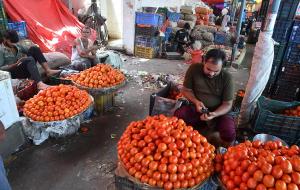Live Classes

October’s inflation data point to a welcome softening in price gains that should offer some succour to monetary policy authorities, who have been battling to rein in runaway inflation since the beginning of this year. Retail inflation, or price gains based on the Consumer Price Index, slowed to 6.77% last month, from September’s 7.41%, aided by an appreciable deceleration in food price inflation.
Why the fall in inflation
The year-on-year inflation based on the Consumer Food Price Index eased by almost 160 basis points in October, to 7.01%, from the preceding month’s 8.60%, helped by a “decline in prices of vegetables, fruits, pulses and oils and fats”, the Government said. With the food and beverages sub-index representing almost 46% of the CPI’s weight, the slowdown in food price gains understandably steered overall inflation lower even as price gains in three other essential categories, namely clothing and footwear, housing, and health, remained either little changed from September or quickened.
Wholesale price index also declined
Inflation at the wholesale prices level also continued to decelerate, with the headline reading easing into single digits for the first time in 19 months. A favourable base effect along with a distinct cooling in international prices of commodities including crude oil and steel amid gathering uncertainty in advanced economies was largely instrumental in tempering wholesale price gains.
Why policy makers need to be vigilant
Still, a closer look at sequential trends in retail inflation, especially in food items, flag the imperative for policymakers to remain watchful. While year-on-year inflation in vegetable prices slowed sharply to 7.77% last month, from September’s breathless 18% pace, the month-on-month gains accelerated to a four-month high of 4.1% and point to concerns that the supply disruptions caused by unseasonal rains in vegetable-growing regions as well as logistical difficulties posed by monsoon flooding may continue to keep prices volatile, at least in the near term.
Government's effort and concern
Prices of staple cereals including rice and wheat also remain an object of concern, notwithstanding the Government’s concerted efforts to cool volatility using export control measures. While inflation in the largest weight in the food basket ticked up to 12.1% in October, from the previous month’s 11.5%, sequentially, price gains came in at 1%, moderating in pace from September.
Reports of paddy crops being submerged or affected by heavy rains in different parts of the country coupled with the shortages of wheat and flour that have pushed up their prices all signal more volatility ahead in cereal prices. With S&P Global’s latest Business Outlook survey pointing to an intensification of wage pressures and producer pass-through of costs, authorities can ill-afford to drop their guard in the fight against inflation.
GS Paper 3: indian Economy
Download pdf to Read More